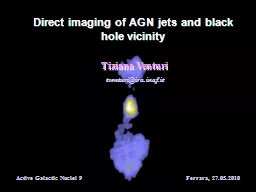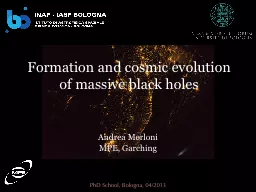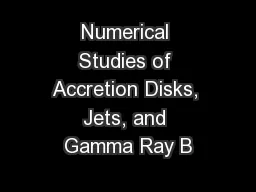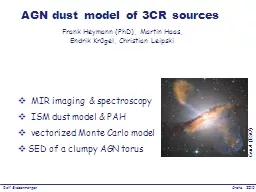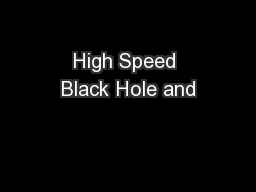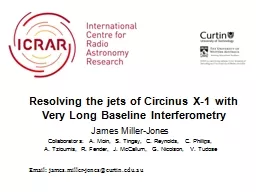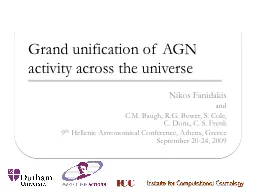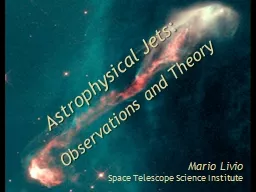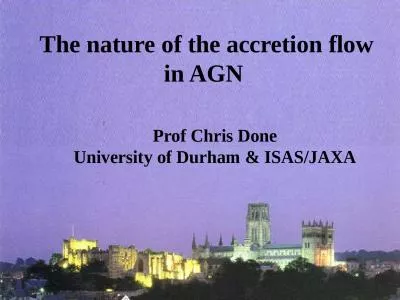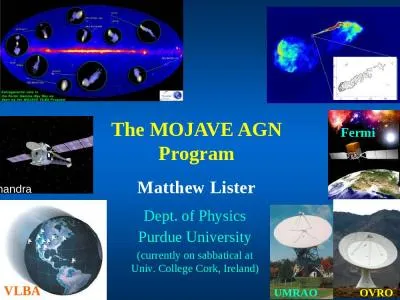PPT-Direct imaging of AGN jets and black hole vicinity
Author : trish-goza | Published Date : 2016-06-26
Tiziana Venturi tventuriirainafit Active Galactic Nuclei 9 Ferrara 27052010 Radio VLBI as the most direct way to
Presentation Embed Code
Download Presentation
Download Presentation The PPT/PDF document "Direct imaging of AGN jets and black hol..." is the property of its rightful owner. Permission is granted to download and print the materials on this website for personal, non-commercial use only, and to display it on your personal computer provided you do not modify the materials and that you retain all copyright notices contained in the materials. By downloading content from our website, you accept the terms of this agreement.
Direct imaging of AGN jets and black hole vicinity: Transcript
Tiziana Venturi tventuriirainafit Active Galactic Nuclei 9 Ferrara 27052010 Radio VLBI as the most direct way to. Ramesh Narayan. Jets are Widespread. Relativistic Jets . occur widely in . accreting black holes (BHs): AGN, XRBs, GRBs. A . common . robust . mechanism . must be producing all these . Jets. Best Bet. Formation and cosmic evolution of massive black holes. Andrea Merloni. MPE, Garching. Syllabus. Monday:. Observational evidence of Supermassive Black Holes. AGN surveys. Tuesday: . The evolution of SMBH mass function and spin distributions. Gamma ray bursts (GRB) are an especially exciting outflow phenomena that are capable of outputting as much energy as our sun will. Christopher C. . Lindner. 1. Abstract. Relativistic Jets are streams of plasma moving throughout the universe at speeds up to 99% the speed of light. They produce high-energy X-ray, radio, and visible radiation that are observable from great distances across the universe. . . . . MIR imaging & . s. pectroscopy. ISM dust model & PAH. . vectorized. Monte Carlo model . SED of a clumpy AGN torus. Frank . Heymann. (PhD), Martin Haas, . Endrik. . Kr. は階層的銀河形成論で説明. できるか?. Motohiro. . Enoki. Tomoaki Ishiyama (Tsukuba Univ.). Masakazu A. R. Kobayashi (Ehime Univ.). Masahiro . Nagashima. . (Nagasaki Univ. .). §1. Introduction. Soliton. Collisions. Frans. Pretorius. Princeton University. . Workshop on. Tests of Gravity and Gravitational Physics. May 19-21, 2009. Case Western Reserve University, Cleveland, Ohio. Outline. Why explore high speed black . The View From Telescopes, Computers. and the Lab. Adam Frank. University of Rochester. A Cast Of Lots and Lots. AstroBEAR development. : J. Carroll, B. . Lui. , M. . Huarte. -Espinosa, S. Li, E. Hanson, E. Kaminski, K. . Circinus. X-1 with Very Long Baseline . Interferometry. James Miller-Jones. Collaborators: A. . Moin. , S. . Tingay. , C. Reynolds, C. Phillips, . A. . Tzioumis. , R. Fender, J. McCallum, G. Nicolson, V. . Nikos Fanidakis. and. C.M. Baugh, R.G. Bower, S. Cole, C. Done, C. S. . Frenk. 9. th. Hellenic Astronomical Conference, Athens, Greece September 20-24, 2009. L. David . Kubiz. ňák. (Perimeter Institute). . Lambda and Quasi-Lambda workshop. University of Massachusetts, Amherst, MA, USA. April 10 – April 12, 2014. Plan of the talk. Black holes as thermodynamic objects . Theory. Mario Livio. Space Telescope Science Institute. Which Systems Have Highly Collimated . Jets. ?. Object . Physical System. Young Stellar Objects. Accreting Star. HMXBs. Accreting NS or BH. X-ray Transients. Screw And Surface. Counterbore. Countersink. Threaded hole. Clearance Hole. Prof Chris Done. University . of Durham & ISAS/JAXA. AGN feedback. Magorrian-Gebhardt. relation gives BH mass!! Big black holes live in host galaxies with big bulges! Either measured by bulge luminosity or bulge mass (stellar velocity dispersion) or . Purdue University. (currently on sabbatical at Univ. College Cork, Ireland). Matthew Lister. VLBA. Fermi. UMRAO. OVRO. Chandra. MOJAVE Collaborators. M. Lister (P.I.), N. Cooper, B. Hogan, S. . Kuchibhotla.
Download Document
Here is the link to download the presentation.
"Direct imaging of AGN jets and black hole vicinity"The content belongs to its owner. You may download and print it for personal use, without modification, and keep all copyright notices. By downloading, you agree to these terms.
Related Documents

